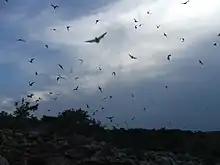Cryptic rabies
Cryptic rabies refers to infection from unrecognized exposure to rabies virus. It is often phylogenetically traced to bats. It is most often seen in the southern United States. Silver-haired bats (Lasionycteris noctivagans) and tricolored bats (Perimyotis subflavus) are the two most common bat species associated with this form of infection, though both species are known to have less contact with humans than other bat species such as the big brown bat. That species is common throughout the United States and often roosts in buildings and homes where human contact is more likely.[1][2]

Transmission
Cryptic rabies refers to instances where rabies occurs in an individual with no clear history of exposure to a rabies vector. Determining history of contact, usually via the bite of an infected animal, can be difficult if the patient is unconscious or incoherent by the time an attempt is made to collect patient history. Thus, friends and family are needed to fill in patient history of possible bite exposure. Additionally, bites from a vector can be overlooked, particularly for some small bat species. Bites from a bat can be so small that they are not visible without magnification equipment, for example. Outside of bites, rabies virus exposure can also occur if infected fluids come in contact with a mucous membrane or a break in the skin. Rabies virus has also been transmitted when an infected human unknowingly dies of rabies, and their organs are transplanted to others.[3]
While it has been speculated that rabies virus could be transmitted through aerosols, studies of the rabies virus have concluded that this is only feasible in limited conditions. These conditions include a very large colony of bats in a hot and humid cave with poor ventilation. While two human deaths in 1956 and 1959 had been tentatively attributed to aerosolization of the rabies virus after entering a cave with bats, "investigations of the 2 reported human cases revealed that both infections could be explained by means other than aerosol transmission".[3]
Species specific reservoir
It is not well understood why most, but not all, cases of cryptic bat rabies can be traced to silver-haired bats and tricolored bats, but it is believed that the strain of rabies virus in these species is particularly virulent.[4][5][6]
References
- Messenger, Sharon L.; Smith, Jean S.; Orciari, Lillian A.; Yager, Pamela A.; Rupprecht, Charles E. (February 2003). "Emerging Pattern of Rabies Deaths and Increased Viral Infectivity". Emerging Infectious Diseases. 9 (2): 151–154. doi:10.3201/eid0902.020083. PMC 2901935. PMID 12603983.
- Messenger, Sharon L.; Smith, Jean S.; Rupprecht, Charles E. (15 September 2002). "Emerging Epidemiology of Bat‐Associated Cryptic Cases of Rabies in Humans in the United States". Clinical Infectious Diseases. 35 (6): 738–747. doi:10.1086/342387. PMID 12203172.
- Messenger, Sharon L.; Smith, Jean S.; Rupprecht, Charles E. (2002). "Emerging Epidemiology of Bat‐Associated Cryptic Cases of Rabies in Humans in the United States". Clinical Infectious Diseases. 35 (6): 738–747. doi:10.1086/342387. PMID 12203172.
- Warrell, MJ; Warrell, DA (March 2004). "Rabies and other lyssavirus diseases". The Lancet. 363 (9413): 959–969. doi:10.1016/S0140-6736(04)15792-9. PMID 15043965.
- Winkler, W. G. (April 1968). "Airborne Rabies Virus Isolation". Bulletin of the Wildlife Disease Association. 4 (2): 37–40. doi:10.7589/0090-3558-4.2.37. PMID 4870805.
- Winkler, William G.; Baker, Everette F.; Hopkins, Cyrus C. (March 1972). "An outbreak of non-bite transmitted rabies in a laboratory animal colony". American Journal of Epidemiology. 95 (3): 267–277. doi:10.1093/oxfordjournals.aje.a121394. PMID 4551654.
External links
- "Virus Pathogen Database and Analysis Resource (ViPR) - Rhabdoviridae - Genome database with visualization and analysis tools". Archived from the original on 2019-09-12. Retrieved 2013-07-28.